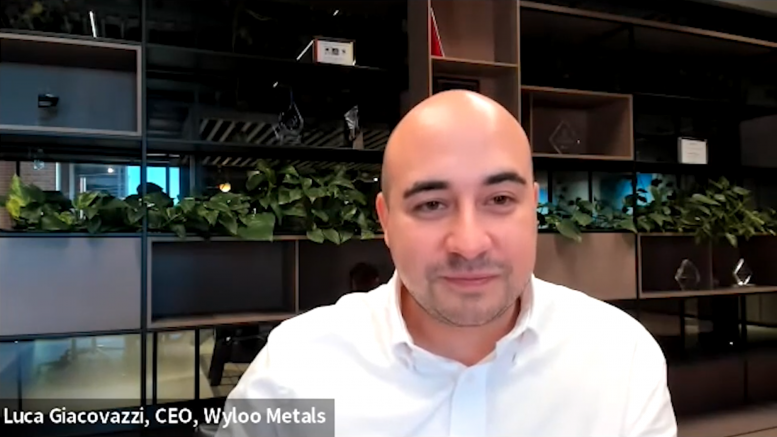Multinational Wyloo Metals has reiterated its commitment to establishing an Ontario-centric integrated critical minerals supply chain, CEO Luca Giacovazzi told The Northern Miner’s recent Global Mining Symposium.
The privately-held Australian company, part of billionaire Andrew Forrest’s business empire, has made an early commitment to see the nickel and concentrate produced out of its Eagle’s Nest project in Ontario’s emerging Ring of Fire (RoF) nickel-chromite mining camp processed and beneficiated in Canada.
Wyloo has billed Eagle’s Nest as Canada’s most significant high-grade nickel discovery since the Voisey’s Bay deposit was found in the eastern province of Newfoundland and Labrador.
“We want to see the nickel we produce go into a battery metals plant somewhere in Ontario, that can ultimately end up hopefully in a Gigafactory somewhere in Ontario, and in a car that’s manufactured in the province,” he said during a pre-recorded interview.
Giacovazzi pointed out one of the corporate tenets of the recently rebranded Ring of Fire Metals (formerly Noront Resources) embraces the slogan ‘We’re Canada to the core.’ “We’re deploying our ‘three P’ approach – People, Planet, Project.”
He said Ontario has a once-in-a-generation opportunity to become a world-leading hub for producing the critical minerals the world needs to de-carbonize. “We want to play our part in connecting the minerals in the north with the manufacturing might in the south,” he said.
The development of the vast muskeg wetlands of northern Ontario will act like an economic dynamo, connecting far-flung rural Indigenous communities by road for the first time. Giocovazzi says he has good news for them.
“We’ll need every able-bodied man and woman in the communities to work on the mine site to run Eagle’s Nest, including all the other ancillary support services, so there’s a tremendous opportunity to employ out of the communities,” he said.
“And the best part is that the people from the communities we hire from are already near the project. They know how to operate in very remote conditions, so they are the best employees you can ask for,” he said.
The second part concerns Indigenous procurement, and the company started with a $100 million commitment. “I actually think that can become much bigger,” Giacovazzi said.
As it stands, he estimates Ring of Fire Metals employs about 40-50% First Nation members across the business.
Controlling position
Giacovazzi ascribes foresight and luck to Wyloo gaining the dominant land position in the RoF. In scouring global geological databases, the executive recalls that Canada was always at the top among ideal nickel project jurisdictions.
“When we met with the Noront management team, we really liked the approach they were taking with the First Nations communities and with the government and letting the First Nations communities be proponents for the infrastructure development. I love that approach, aligned with it, so we decided to make an initial investment in Noront.
“Then fast forward a few months, and BHP had the same idea. And we got into a takeover tussle with BHP. And obviously, we’re thankful that we’ve emerged as the owners of the RoF.”
The company describes the RoF mineral belt as an extraordinary opportunity. According to Giacovazzi, the best analogy for considering it is to compare it with how the Sudbury Basin looked 150 years ago.
“Now the RoF is a little bit different. We already know quite a lot about it – there are billions of dollars of metal sitting in the ground that we know about. But the more exciting part of the story is that it hasn’t been touched from a modern exploration perspective,” he said.
According to Giacovazzi, for every square kilometre in the Sudbury Basin, there is the equivalent of one exploration drill hole, compared with one drill hole for every 40 sq. km in the RoF today.
“We strongly believe that there are two or three Eagle’s Nest orebodies in the RoF in addition to the chrome, copper, zinc, in the other orebodies already known,” he said.
Advanced design
The company previously said it hopes to start commercial production at Eagle’s Nest in 2026, with the initial mine life at 11 years.
“We have a stars-aligned situation; we’re very lucky,” Giacovazzi said.
“Not only is it a wonderful, very high grade, perfectly vertical orebody (which is if you ask the geologist to design an orebody, that’s what it would look like), but we’re also in a very fortunate position where there’s an infrastructure corridor and a road that is being developed,” the executive points out.
The road needs aggregate, and the company has looked at supplying the aggregate out of Eagle’s Nest, leaving it with big underground voids where tailings can be deposited.
“So, at the surface, Eagle’s Nest will be a 1-sq.-km development footprint, but of that space, we’re only hoping to disturb about 30%,” he said.
“It’s a great model for how mining should be done in the future using an environmentally tiny footprint.
“The nickel we get out of Eagle’s Nest should be enough to make 10 million EVs. So, from an environmental perspective, the net benefit is massive.”
Rare earths
Amongst its diversified portfolio of assets, including gold and downstream metal processing investments, besides the RoF, Giacovazzi said he gets most excited by the rare earths opportunities.
“My favourite commodity in the world to talk about are rare earths. And the reason is they’re the closest thing to magic that we’re ever going to get,” he said.
He illustrated his point by explaining how rare earths are critical to making technologies more energy efficient.
An excellent example of that is an EV’s electric motor. “If you had replaced a normal magnet with a rare earth magnet, you’re probably 20 to 30 times more efficient, which means you can have a 20 to 30 times smaller battery. This means you can make the car more affordable, you can make it lighter, you can make it greener,” Giacovazzi explained.
In August 2022, Wyloo announced a $150 million investment in Australian rare earths developer Hastings Technology Metals, through which it obtained a 22.1% stake in Canada-focused Neo Performance Materials (TSX: NEO).
“This transaction with Hastings spans the value chain, from mining to magnet manufacturing. As the owner of Europe’s only commercial rare earth metals facility, Neo is strategically placed to help Europe meet its goal to become climate neutral by 2050,” Giacovazzi said.
Watch the interview here.






Be the first to comment on "GMS: Wyloo hopes to integrate Ontario-based Ring of Fire nickel supply chain"